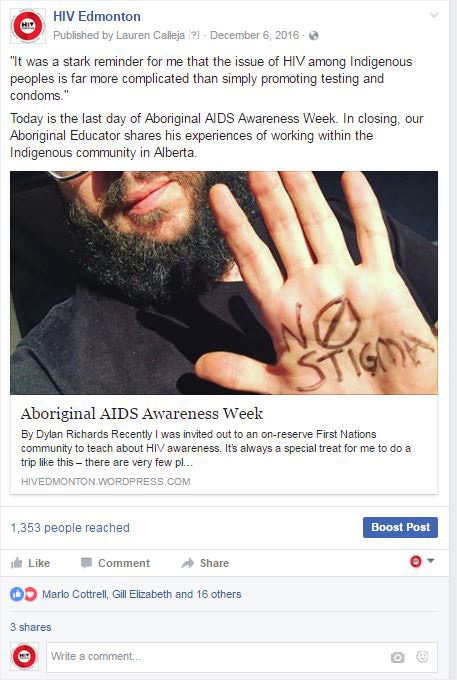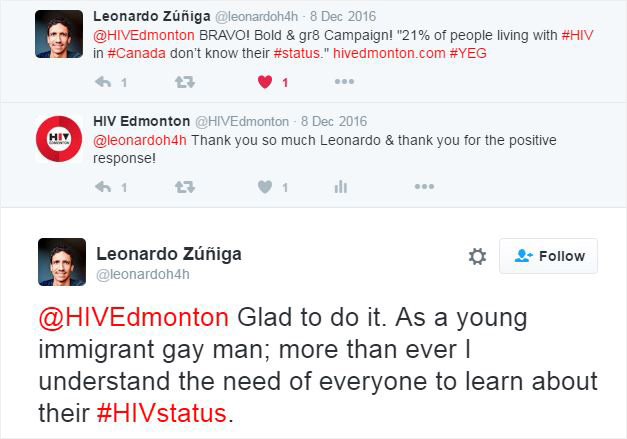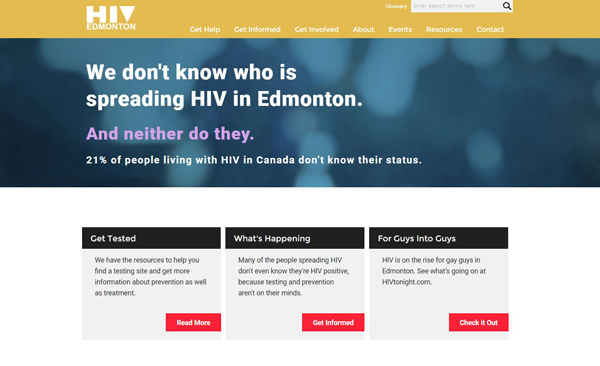
A few years ago, HIV Edmonton decided it needed an online makeover. The organization, which serves people who are living with HIV and marginalized individuals in inner-city Edmonton, Canada, had a beautifully designed office space and a range of interesting programs, but its web presence was noted to be lacking.
Under the leadership of the newly hired Director of Resource Development & Public Engagement, a process of strategic rebranding was put in place, including a major overhaul of HIV Edmonton’s web and social media presence. Though the organization’s communication team is small (two staff members who have a range of other responsibilities), they have managed to strategically and successfully integrate social media in their communication and outreach activities.
Here are 4 key lessons that HIV Edmonton learned on integrating social media in its communication and outreach activities:
Rather than reinvent the wheel, HIV Edmonton decided to align its new vision with the international “Getting to Zero” campaign developed by UNAIDS in 2011. With its goal of achieving “zero new HIV infections; zero discrimination; and zero AIDS-related deaths,” the campaign resonated with HIV Edmonton’s work — every one of its activities could be captured by this overarching theme.
HIV Edmonton hired a professional agency to develop a new website that centred upon the “Zero” vision. The agency helped to design the look of the website and its infrastructure, making it much more interactive. The communications team at the organization produced the content for the new site, which it continues to do on an ongoing basis. Indeed, to ensure that information is up to date, that their activities are shared in a timely manner, and to maximize its SEO, HIV Edmonton updates its website regularly. With lots of photos albums, links and interactive features, it’s a fun and dynamic site that keeps the user engaged.
In addition to promoting your own work and activities, you should also engage with other people’s work. Tweet out for other organizations or to promote special events that are happening in the community. Build that rapport and that network.
 Along with its website redesign, HIV Edmonton revised its social media strategy, which up until that point had been composed of a Facebook page that presented information but tended to remain otherwise stagnant. With the “Zero” vision on hand, the organization gave its Facebook page a new look, and started to use it much more regularly, posting and sharing information and interacting with the community on a daily basis.
Along with its website redesign, HIV Edmonton revised its social media strategy, which up until that point had been composed of a Facebook page that presented information but tended to remain otherwise stagnant. With the “Zero” vision on hand, the organization gave its Facebook page a new look, and started to use it much more regularly, posting and sharing information and interacting with the community on a daily basis.
Because Edmonton has a very active Twitter scene and this is an important tool for community building, information sharing and civic engagement in the city, the organization launched into Twitter as part of its new social media presence. More recently, with the hire of a staff member who was interested in taking on the challenge of a new medium, HIV Edmonton has started an Instagram account.
The organization’s blog is another venue for community engagement, where guest bloggers are invited to share their views on relevant issues and posts are timed to concord with events happening in Edmonton. The blog allows HIV Edmonton to simultaneously create its own content, while sharing other people’s perspectives.
 HIV Edmonton uses these different platforms to share pieces of its own story but also to participate in the other stories that are happening in the community. In addition to showcasing their services and activities, the organization promotes the work of its collaborators and answers questions from the community.
HIV Edmonton uses these different platforms to share pieces of its own story but also to participate in the other stories that are happening in the community. In addition to showcasing their services and activities, the organization promotes the work of its collaborators and answers questions from the community.
Social media have become a key component in HIV Edmonton’s work to engage in and with the community, complementing their pre-existing approaches. Monthly newsletters sent by email and the continued organization of in-person meetings and events allow the organization to reach those who are not on social media and to engage the community in a variety of ways. Though many of their members and collaborators are active users of social media, it’s important to maintain opportunities to meet in person.
With time and experience, HIV Edmonton has crafted a very precise social media strategy. Any potential new social medium is carefully studied and considered, and if the organization decides to adopt it, its use is regularly monitored and reassessed. The organization is of the mind that social media may be free, but if you can’t be active and visible in a social medium, it’s not beneficial to stay on it.
The communications team is also very precise about the language it uses, to ensure that information is up-to-date and that no individual or group is inadvertently stigmatized through their messaging. As a rule, they have established that if you need to ask anyone whether something may be stigmatizing, then it cannot be shared publicly. Only the two communications staff have access to the social media platforms of the organization – they encourage their colleagues to tag them through their personal accounts, but only they control the social media content and therefore the “voice” of HIV Edmonton produced or shared by the organization.
As a rule, they have established that if you need to ask anyone whether something may be stigmatizing, then it cannot be shared publicly.
While HIV Edmonton is extremely careful about the language it uses and the content it produces, it has a no deletion policy when it comes to other people’s messages. Even if posts may appear negative or bordering on offensive, they are seen as an opportunity to educate and to provide accurate information. This not only echoes the educational mandate which is at the core of the organization, but their commitment to using a professional approach to talking about hard issues. The only time comments are deleted is when they are considered to be scientifically inaccurate, for examples references to witchcraft or to “natural cures” to HIV. The team ensures that every comment is responded to promptly, which also entails making one’s self available in the evenings and on weekends. The communications staff are themselves personally invested social media users, which facilitates this process (the Director of Resource Development & Public Engagement specifies that it is through this work that she developed a personal interest in social media.)
For lessons on how to use these social media as effectively as possible, HIV Edmonton’s communications team looks to the influencers, the ones who have thousands and millions of followers and who are clearly making these social media work for them. Though HIV Edmonton may not be able to afford an entire social media team and specialized advisors, there are lessons to be learned from those who can.
INTERESTING FACTS:
- To maximize efficiency, the communications team uses an online collaboration app called Slack.
- To celebrate the organization’s 30th Anniversary, HIV Edmonton launched the Thirty Faces of HIV project in partnership with a popularly followed site called “Faces of Edmonton.” This was a series of portraits of people living with HIV and advocates, which garnered lots of attention from traditional media. In fact, since have they revamped their online presence, HIV Edmonton has seen a notable increase in calls from news media who are interested in getting their input on a range of issues. More and more, news media are turning to social media to find stories.
- In response to the rising rates of infection among MSM in Edmonton, the organization launched a cheeky education campaign in 2016 called HIV Tonight, which presented prevention options available to men in a frank, fun and non-stigmatizing way. This campaign even won the Grand Clio, Clio Health Award, one of the most prestigious international advertising awards on the planet.

